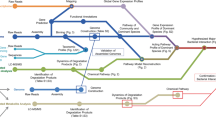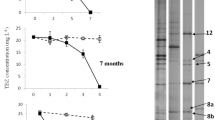Abstract
Bisphenol A (BPA) is a common ingredient in plastic wares and epoxy resins that are essential for our daily life. Despite the obvious benefits, BPA may act as an environmental endocrine disruptor, causing metabolic, reproductive, and/or developmental consequences and diseases in humans and other organisms. Although previous studies have yielded progress toward the microbial breakdown of BPA, the work has primarily been focused on pure cultures rather than complex microbial communities. In this study, we examined microbial communities in bioreactors that control the fate of BPA at various levels (up to 5000 μg L−1). Microbial communities rapidly increased removal rates of 500–5000 μg L−1 BPA from 23–29 to 89–99% during the first 2 weeks of the acclimation period, after which > 90% stable removal rates were maintained over 3 months. Biochemical assays demonstrated that BPA was removed by biodegradation, rather than other abiotic removal routes (e.g., adsorption and volatilization). The 16S rRNA gene-based community analysis revealed that 50–5000 μg L−1 of BPA exposure systematically selected for three Sphingomonadaceae species (Sphingobium, Novosphingobium, and Sphingopyxis). The Sphingomonadaceae-enriched communities acclimated to BPA showed a 7.0-L gVSS−1 day−1 BPA degradation rate constant, which is comparable to that (4.1–6.3) of Sphingomonadaceae isolates and is higher than other potential BPA degraders. Taken together, our results advanced the understanding of how microbial communities acclimate to environmentally relevant levels of BPA, gradually enhancing BPA degradation via selective enrichment of a few Sphingomonadaceae populations with higher BPA metabolic activity.




Similar content being viewed by others
References
Im J, Loffler FE (2016) Fate of bisphenol A in terrestrial and aquatic environments. Environ Sci Technol 50:8403–8416. https://doi.org/10.1021/acs.est.6b00877
Corrales J, Kristofco LA, Steele WB, Yates BS, Breed CS, Williams ES, Brooks BW (2015) Global assessment of bisphenol A in the environment: review and analysis of its occurrence and bioaccumulation. Dose-Response 13:1559325815598308. https://doi.org/10.1177/1559325815598308
Meesters RJ, Schroder HF (2002) Simultaneous determination of 4-nonylphenol and bisphenol A in sewage sludge. Anal Chem 74:3566–3574. https://doi.org/10.1021/ac011258q
Fukazawa H, Watanabe M, Shiraishi F, Shiraishi H, Shiozawa T, Matsushita H, Terao Y (2002) Formation of chlorinated derivatives of bisphenol A in waste paper recycling plants and their estrogenic activities. J Health Sci 48:242–249. https://doi.org/10.1248/jhs.48.242
Yamamoto T, Yasuhara A, Shiraishi H, Nakasugi O (2001) Bisphenol A in hazardous waste landfill leachates. Chemosphere 42:415–418. https://doi.org/10.1016/S0045-6535(00)00079-5
Vandenberg LN, Maffini MV, Sonnenschein C, Rubin BS, Soto AM (2009) Bisphenol-A and the great divide: a review of controversies in the field of endocrine disruption. Endocr Rev 30:75–95. https://doi.org/10.1210/er.2008-0021
Wright-Walters M, Volz C, Talbott E, Davis D (2011) An updated weight of evidence approach to the aquatic hazard assessment of bisphenol A and the derivation a new predicted no effect concentration (Pnec) using a non-parametric methodology. Sci Total Environ 409:676–685. https://doi.org/10.1016/j.scitotenv.2010.07.092
Watts MM, Pascoe D, Carroll K (2003) Exposure to 17 alpha-ethinylestradiol and bisphenol A—effects on larval moulting and mouthpart structure of Chironomus riparius. Ecotoxicol Environ Saf 54:207–215. https://doi.org/10.1016/s0147-6513(02)00029-5
Marcial HS, Hagiwara A, Snell TW (2003) Estrogenic compounds affect development of harpacticoid copepod Tigriopus japonicus. Environ Toxicol Chem 22:3025–3030
Sohoni P, Tyler CR, Hurd K, Caunter J, Hetheridge M, Williams T, Woods C, Evans M, Toy R, Gargas M, Sumpter JP (2001) Reproductive effects of long-term exposure to bisphenol A in the fathead minnow (Pimephales promelas). Environ Sci Technol 35:2917–2925. https://doi.org/10.1021/es000198n
Mandich A, Bottero S, Benfenati E, Cevasco A, Erratico C, Maggioni S, Massari A, Pedemonte F, Vigano L (2007) In vivo exposure of carp to graded concentrations of bisphenol A. Gen Comp Endocrinol 153:15–24. https://doi.org/10.1016/j.ygcen.2007.01.004
Li G, Zu L, Wong PK, Hui X, Lu Y, Xiong J, An T (2012) Biodegradation and detoxification of bisphenol A with one newly-isolated strain Bacillus sp. GZB: kinetics, mechanism and estrogenic transition. Bioresour Technol 114:224–230. https://doi.org/10.1016/j.biortech.2012.03.067
Zuhlke MK, Schluter R, Mikolasch A, Zuhlke D, Giersberg M, Schindler H, Henning AK, Frenzel H, Hammer E, Lalk M, Bornscheuer UT, Riedel K, Kunze G, Schauer F (2017) Biotransformation and reduction of estrogenicity of bisphenol A by the biphenyl-degrading Cupriavidus basilensis. Appl Microbiol Biotechnol 101:3743–3758. https://doi.org/10.1007/s00253-016-8061-z
Peng YH, Chen YJ, Chang YJ, Shih YH (2015) Biodegradation of bisphenol A with diverse microorganisms from river sediment. J Hazard Mater 286:285–290. https://doi.org/10.1016/j.jhazmat.2014.12.051
Luo Y, Guo W, Ngo HH, Nghiem LD, Hai FI, Zhang J, Liang S, Wang XC (2014) A review on the occurrence of micropollutants in the aquatic environment and their fate and removal during wastewater treatment. Sci Total Environ 473-474:619–641. https://doi.org/10.1016/j.scitotenv.2013.12.065
Guerra P, Kim M, Teslic S, Alaee M, Smyth SA (2015) Bisphenol-A removal in various wastewater treatment processes: operational conditions, mass balance, and optimization. J Environ Manag 152:192–200. https://doi.org/10.1016/j.jenvman.2015.01.044
Ferro Orozco AM, Lobo CC, Contreras EM, Zaritzky NE (2013) Biodegradation of bisphenol-A (BPA) in activated sludge batch reactors: analysis of the acclimation process. Int Biodeterior Biodegrad 85:392–399. https://doi.org/10.1016/j.ibiod.2013.09.005
Zhao J, Li Y, Zhang C, Zeng Q, Zhou Q (2008) Sorption and degradation of bisphenol A by aerobic activated sludge. J Hazard Mater 155:305–311. https://doi.org/10.1016/j.jhazmat.2007.11.075
Oh S, Tandukar M, Pavlostathis SG, Chain PS, Konstantinidis KT (2013) Microbial community adaptation to quaternary ammonium biocides as revealed by metagenomics. Environ Microbiol 15:2850–2864. https://doi.org/10.1111/1462-2920.12154
Joss A, Zabczynski S, Gobel A, Hoffmann B, Loffler D, McArdell CS, Ternes TA, Thomsen A, Siegrist H (2006) Biological degradation of pharmaceuticals in municipal wastewater treatment: proposing a classification scheme. Water Res 40:1686–1696. https://doi.org/10.1016/j.watres.2006.02.014
APHA (2005) Standard methods for the examination of water and wastewater21st edn. American Public Health Association, Washington, DC
Kozich JJ, Westcott SL, Baxter NT, Highlander SK, Schloss PD (2013) Development of a dual-index sequencing strategy and curation pipeline for analyzing amplicon sequence data on the MiSeq Illumina sequencing platform. Appl Environ Microbiol 79:5112–5120. https://doi.org/10.1128/AEM.01043-13
Mai DT, Stuckey DC, Oh S (2018) Effect of ciprofloxacin on methane production and anaerobic microbial community. Bioresour Technol 261:240–248. https://doi.org/10.1016/j.biortech.2018.04.009
Kim JY, Ryu K, Kim EJ, Choe WS, Cha GC, Yoo IK (2007) Degradation of bisphenol A and nonylphenol by nitrifying activated sludge. Process Biochem 42:1470–1474. https://doi.org/10.1016/j.procbio.2007.06.010
Seyhi B, Drogui P, Buelna G, Blais JF (2012) Removal of bisphenol-A from spiked synthetic effluents using an immersed membrane activated sludge process. Sep Purif Technol 87:101–109. https://doi.org/10.1016/j.seppur.2011.11.029
Nie YF, Qiang ZM, Zhang HQ, Ben WW (2012) Fate and seasonal variation of endocrine-disrupting chemicals in a sewage treatment plant with A/A/O process. Sep Purif Technol 84:9–15. https://doi.org/10.1016/j.seppur.2011.01.030
Samaras VG, Stasinakis AS, Mamais D, Thomaidis NS, Lekkas TD (2013) Fate of selected pharmaceuticals and synthetic endocrine disrupting compounds during wastewater treatment and sludge anaerobic digestion. J Hazard Mater 244-245:259–267. https://doi.org/10.1016/j.jhazmat.2012.11.039
Stasinakis AS, Gatidou G, Mamais D, Thomaidis NS, Lekkas TD (2008) Occurrence and fate of endocrine disrupters in Greek sewage treatment plants. Water Res 42:1796–1804. https://doi.org/10.1016/j.watres.2007.11.003
Hyland KC, Dickenson ER, Drewes JE, Higgins CP (2012) Sorption of ionized and neutral emerging trace organic compounds onto activated sludge from different wastewater treatment configurations. Water Res 46:1958–1968. https://doi.org/10.1016/j.watres.2012.01.012
Das S, Ray NM, Wan J, Khan A, Chakraborty T, Ray MB (2017) Micropollutants in wastewater: fate and removal processes. In: Farooq R, Ahmad Z (eds) Physico-chemical wastewater treatment and resource recovery. InTech, Rijeka, pp 81–89
Saunders AM, Albertsen M, Vollertsen J, Nielsen PH (2016) The activated sludge ecosystem contains a core community of abundant organisms. ISME J 10:11–20. https://doi.org/10.1038/ismej.2015.117
Balkwill DL, Fredrickson JK, Romine MF (2006) Sphingomonas and related genera. In: Dworkin M, Falkow S, Rosenberg E, Schleifer K-H, Stackebrandt E (eds) The prokaryotes: Volume 7: Proteobacteria: Delta, Epsilon Subclass. Springer New York, New York, pp 605–629
Zhou NA, Lutovsky AC, Andaker GL, Gough HL, Ferguson JF (2013) Cultivation and characterization of bacterial isolates capable of degrading pharmaceutical and personal care products for improved removal in activated sludge wastewater treatment. Biodegradation 24:813–827. https://doi.org/10.1007/s10532-013-9630-9
Li Y, Toyama T, Furuya T, Iwanaga K, Tanaka Y, Mori K (2014) Sustainable biodegradation of bisphenol A by Spirodela polyrhiza in association with Novosphingobium sp. FID3. J Water Environ Technol 12:43–54. https://doi.org/10.2965/jwet.2014.43
Toyama T, Sato Y, Inoue D, Sei K, Chang YC, Kikuchi S, Ike M (2009) Biodegradation of bisphenol A and bisphenol F in the rhizosphere sediment of Phragmites australis. J Biosci Bioeng 108:147–150. https://doi.org/10.1016/j.jbiosc.2009.03.011
Hu A, Lv M, Yu CP (2013) Draft genome sequence of the bisphenol A-degrading bacterium Sphingobium sp. strain YL23. Genome Announc 1. doi: https://doi.org/10.1128/genomeA.00549-13
Stolz A (2009) Molecular characteristics of xenobiotic-degrading sphingomonads. Appl Microbiol Biotechnol 81:793–811. https://doi.org/10.1007/s00253-008-1752-3
Lopez-Echartea E, Macek T, Demnerova K, Uhlik O (2016) Bacterial biotransformation of pentachlorophenol and micropollutants formed during its production process. Int J Environ Res Public Health 13. doi: https://doi.org/10.3390/ijerph13111146
Guo P, Wang BZ, Hang BJ, Li L, Li SP, He J (2010) Sphingobium faniae sp. nov., a pyrethroid-degrading bacterium isolated from activated sludge treating wastewater from pyrethroid manufacture. Int J Syst Evol Microbiol 60:408–412. https://doi.org/10.1099/ijs.0.009795-0
Sohn JH, Kwon KK, Kang JH, Jung HB, Kim SJ (2004) Novosphingobium pentaromativorans sp. nov., a high-molecular-mass polycyclic aromatic hydrocarbon-degrading bacterium isolated from estuarine sediment. Int J Syst Evol Microbiol 54:1483–1487. https://doi.org/10.1099/ijs.0.02945-0
Fida TT, Moreno-Forero SK, Breugelmans P, Heipieper HJ, Roling WF, Springael D (2017) Physiological and transcriptome response of the polycyclic aromatic hydrocarbon degrading Novosphingobium sp. LH128 after inoculation in soil. Environ Sci Technol 51:1570–1579. https://doi.org/10.1021/acs.est.6b03822
Kertesz MA, Kawasaki A (2010) Hydrocarbon-degrading Sphingomonads: Sphingomonas, Sphingobium, Novosphingobium, and Sphingopyxis. In: Timmis KN (ed) Handbook of hydrocarbon and lipid microbiology. Springer, Berlin, pp 1693–1705
Sasaki M, Tsuchido T, Matsumura Y (2008) Molecular cloning and characterization of cytochrome P450 and ferredoxin genes involved in bisphenol A degradation in Sphingomonas bisphenolicum strain AO1. J Appl Microbiol 105:1158–1169. https://doi.org/10.1111/j.1365-2672.2008.03843.x
Zhou NA, Kjeldal H, Gough HL, Nielsen JL (2015) Identification of putative genes involved in Bisphenol A degradation using differential protein abundance analysis of Sphingobium sp. BiD32. Environ Sci Technol 49:12232–12241. https://doi.org/10.1021/acs.est.5b02987
Chong NM (2009) Modeling the acclimation of activated sludge to a xenobiotic. Bioresour Technol 100:5750–5756. https://doi.org/10.1016/j.biortech.2009.06.071
Oh S, Kurt Z, Tsementzi D, Weigand MR, Kim M, Hatt JK, Tandukar M, Pavlostathis SG, Spain JC, Konstantinidis KT (2014) Microbial community degradation of widely used quaternary ammonium disinfectants. Appl Environ Microbiol 80:5892–5900. https://doi.org/10.1128/AEM.01255-14
Oh S, Hammes F, Liu WT (2018) Metagenomic characterization of biofilter microbial communities in a full-scale drinking water treatment plant. Water Res 128:278–285. https://doi.org/10.1016/j.watres.2017.10.054
Oh S, Buddenborg S, Yoder-Himes DR, Tiedje JM, Konstantinidis KT (2012) Genomic diversity of Escherichia isolates from diverse habitats. PLoS One 7:e47005. https://doi.org/10.1371/journal.pone.0047005
Funding
This study was supported by a National Research Foundation of Korea (NRF) grant funded by the Korean government (MSIP; Ministry of Science, ICT & Future Planning) (No. NRF-2017R1C1B5076367).
Author information
Authors and Affiliations
Corresponding author
Electronic Supplementary Material
ESM 1
(DOCX 94 kb)
Rights and permissions
About this article
Cite this article
Oh, S., Choi, D. Microbial Community Enhances Biodegradation of Bisphenol A Through Selection of Sphingomonadaceae. Microb Ecol 77, 631–639 (2019). https://doi.org/10.1007/s00248-018-1263-4
Received:
Accepted:
Published:
Issue Date:
DOI: https://doi.org/10.1007/s00248-018-1263-4




